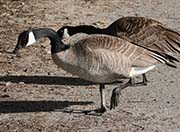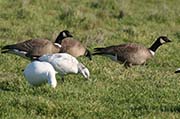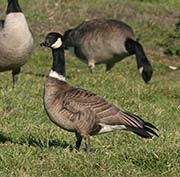Cackling Goose - Branta hutchinsii
| Length | |
| Weight | |
| Clutch Size | |
| Chicks at birth | |
| IUCN Conservation Status | |
Continents: |
The Cackling Goose is a North American bird. The four subspecies of Cackling Goose were originally subspecies of the Canada Goose. In 2004 the American Ornithologist's Union split the Canada Goose into two species: The Canada Goose and the Cackling Goose. The Cackling Goose species has four subspecies:
- Aleutian Cackling Goose - Branta hutchinsii leucopareia
- Cackling Cackling Goose or Cackling Goose - Branta hutchinsii minima
- Richardson's (Hutchin's) Cackling Goose - Branta hutchinsii hutchinsii
- Taverner's (Alaska) Cackling Goose - Branta hutchinsii taverneri
Cackling Geese heads are black with a white chin-strap, the neck is black, and their body varies from light tan to brown with a white undertail. The bill is small and triangular, the iris dark, and the legs and feet dark gray to black. Sexes look similar but the female is slightly smaller. It is not always easy to decide on the subspecies or if it is even a Cackling Goose.
Diet: Diet includes plants including aquatic plants, grains and berries. When feeding in water they will 'dabble' like ducks.
Courtship: Pairs may mate for life (up to 20 years). They breed in coastal marshes along tundra ponds and streams.
Nesting: Nests are a shallow depression in the ground lined with vegetation and down and usually found in an elevated area near water. Aleutian Cackling Geese will build their nests on rocky, cliff-bound shorelines.
Habitat and Range: They are a North American bird that breeds in the tundra in northern Canada and Alaska. Winters are spent in most of the U.S., and western Canada and northern Mexico.
Vocalization: Raucous honking, some cackling.
Plumage/Molt: No alternate plumage.
Migration: They are natural migrants but some feral populations are sedentary. They are frequently found with other geese such as the Canada Geese on wintering grounds.
Tongue/feet: Dark-gray/black legs and feet.
Bibliography:
- http://en.wikipedia.org The Free Encyclopedia, Accessed January, 2014
- http://www.allaboutbirds.org The Cornell Lab of Ornithology All About Birds, Accessed January, 2014
- http://www.oceanwanders.com/CAGO.Subspecies.html#cackling On-line resource for serious birders and pelagic enthusiasts, Accessed January, 2014
- del Hoyo, Josep, Elliott, Andrew, Sargatal, Jordi, et.al., Handbook of the Birds of the World,Lynx Edicions





